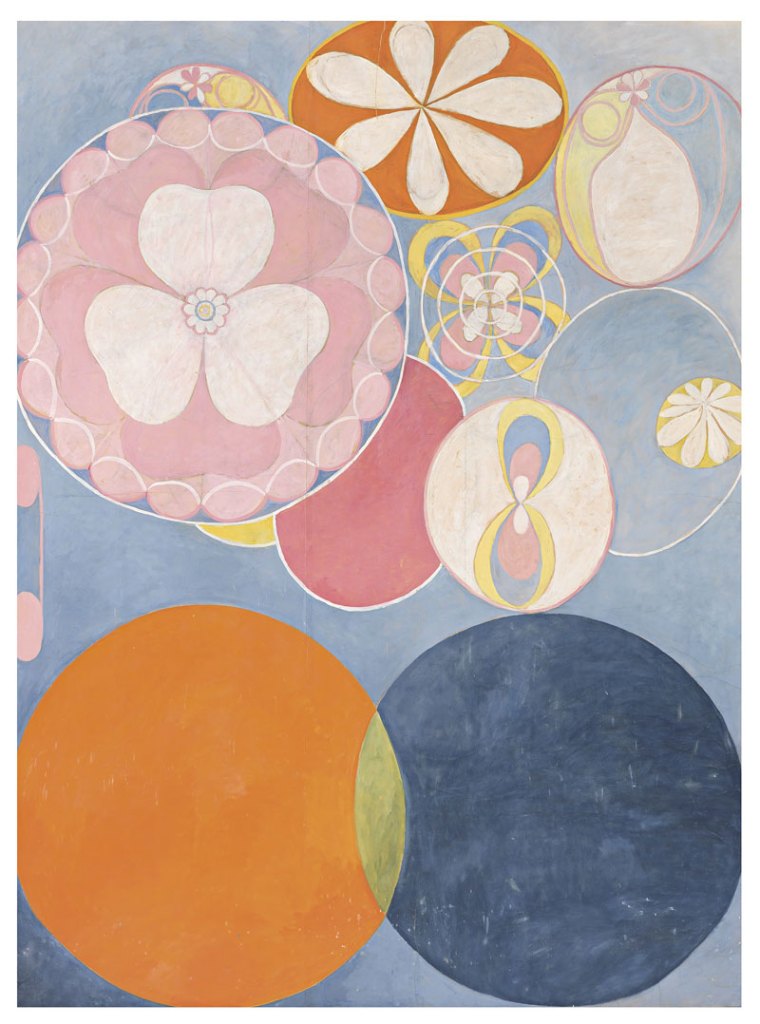You could call it the ‘Van Gogh factor’ – the aura that clings to a distinctive artist who was unrecognised during their lifetime. There is romance in this, and a chance to feel we are setting the record straight. It is curatorial gold – something apparently confirmed by the praise heaped on the Serpentine’s new exhibition of work by Swedish painter Hilma af Klint (1862–1944), only the second in Britain to date.
Hilma af Klint was an impressionist landscape painter by profession, but is known today for creating a series of cosmically-inspired abstract works that predate the early experiments in non-representation by more famous ‘pioneers’ such as Wassily Kandinsky and Robert Delaunay. Unlike the long-suffering Van Gogh, af Klint kept these endeavours resolutely hidden. The artist extended a moratorium on exhibiting The Paintings for the Temple – her main body of abstract works – for 20 years after her death: the paintings were not actually shown until 1986.
Group IV, No. 2. The Ten Largest, Childhood (1907), Hilma af Klint. Courtesy of Stiftelsen Hilma af Klints Verk. Photo: Moderna Museet / Stockholm

It’s not hard to see why af Klint was reticent about her experimental side. Her works have a pagan intensity, symbolic and monumental, that can be simply baffling. This is the case with a series of paintings from 1907 known as The Ten Largest, which, as the title suggests, are enormous – three metres tall – and present crowded conflagrations of organic and geometric shapes against pastel backgrounds. Other works more explicitly reveal her background as an esoteric spiritualist, who conducted séances with other female artists and saw her work as a ‘commission’ from the ‘High Masters’ of another dimension. The 193 Paintings for the Temple, which come in series such as Primordial Chaos (1906–07) and Evolution (1908), were largely an attempt to outline her cosmology through an immense variety of symbols, from swans and doves to letters and colours.
Group IX/SUW, No. 1. The Swan, No.1, by Hilma af Klint. Courtesy of Stiftelsen Hilma af Klints Verk. Photo: Moderna Museet / Stockholm

The clandestine nature of af Klint’s work is a helpful get-out clause for a critic, since her eccentric style is more or less impossible to pin down with conventional vocabulary or value judgements. She strikes me as a wonderful colourist on occasion, although her paintings are often convoluted. But what is the point of saying even this? Like William Blake, af Klint was not answering to any worldly authority. All you can do is marvel at the energy.
There are pitfalls to bringing overlooked artists into the spotlight. They tend to be remade in the image of our present desires; appropriated for political ends, caricatured with phrases like ‘rebel par excellence’. The Serpentine has admirably avoided this with a measured collection of essays. Here we learn, for instance, that some of the more famous abstract painters were also interested in spiritualism, that af Klint herself was equally interested in science, and that Sweden was – comparatively speaking – accepting of female artists during her lifetime.
Group X, No. 1. Altarpiece, by Hilma af Klint. Courtesy of Stiftelsen Hilma af Klints Verk. Photo: Moderna Museet / Stockholm

Ultimately, though, the greatest value of art-historical anomalies like af Klint does not stem from their elusiveness, nor from their canon-defying dates (already I see people claiming that Georgiana Houghton, whose work goes on show at the Courtauld later this year, predates af Klint in the abstraction stakes). It is that their work tends to make us abandon the generic lenses we habitually apply to art. To call af Klint abstract, for instance, is a category error, since she was independent of this discourse. Such perspective must be a good thing, even if it leaves us without much to say.
‘Hilma af Klint: Painting the Unseen’ is at the Serpentine Gallery, London, until 15 May.
Group IX/SUW, No. 17. The Swan, No. 17, by Hilma af Klint. Courtesy of Stiftelsen Hilma af Klints Verk. Photo: Moderna Museet / Stockholm




